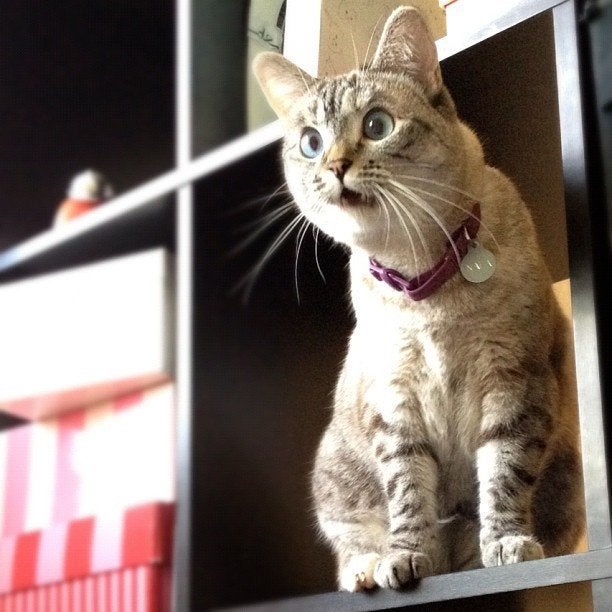
As declawing of kitties becomes less and less popular, people owned by cats and pet product manufacturers are dreaming up ever more creative ways to help your cat do his thing, without destroying your home.
The mesmerizing array of cat scratchers available on the market is a good example.
Learn the How, What and Where of Your Cat's Scratching Behavior
If you've just acquired a new kitten or adult cat, ideally you planned ahead. You set up appropriate scratching surfaces around your home which are perfectly suited for her, and your new furry family member is already using them.
But what if that's only what you wish you'd done (or tried without success to do), and kitty is now hard at work on the corner of your sofa or a section of your carpet?
The best thing to do is observe her scratching behavior and try to match your scratcher purchase to it. Some kitties scratch horizontally. Some reach high overhead vertically for a good back stretch. Some lie on their backs and scratch a surface above them.
Also observe what types of surface your cat prefers to scratch. Some cats prefer soft fabric while others like wood flooring.
Buy or make cat scratchers that will satisfy both your kitty's preferred scratching position and surface. This might involve more than one scratcher design.
Persuading Kitty to Use the Scratcher
When you have your scratching surfaces ready to go, they need to be placed where they'll be used. Remember, clawing is in part a marking behavior for your cat, so it's likely she's returning to the same place to scratch.
It's doubtful your cat scratchers compliment the décor of your home, but unfortunately, they need to be located as close to that sofa corner or section of carpet as possible in order to entice kitty. You can also try locating one in front of the window she looks out of, her feeding area or her litter box.
Sticking the scratchers in out-of-the-way spots your cat doesn't frequent is unlikely to solve the problem.
Encourage your cat to explore the scratcher using a lure like a feather toy or a toy with some catnip rubbed on it. Offer praise and treats each time she uses the post and especially when she digs her claws into it.
The idea is to make it an appealing experience each time she uses the new scratching surface.
Discouraging Illegal Scratching
While you're training your cat to use appropriate scratching surfaces, you'll also need to make any illegal surfaces he's fond of as unattractive as possible to him.
Depending on what surfaces you want to protect, consider using some or a combination of the following kitty scratching deterrents:
• Aluminum foil
• Double-sided tape (your kitty won't tolerate the feel of sticky tape on his paws)
• Plastic sheeting
• Plastic carpet runners, car or chair mats with the spiky sides up
• Inflated balloons
• Herbal spray deterrents
If you're covering surfaces you need to use frequently, like furniture, you can attach the foil, tape or plastic to pieces of cardboard and easily move them in and out of position.
If you're still seeing your cat scratch inappropriate surfaces, try associating an unpleasant sensation or sound to the event. As long as she can't see the person behind the bottle, spray her with water when you catch her in the act.
You can also make a loud, startling sound from around the corner or behind the wall.
What you don't want is to have your pet make a connection between you and the unpleasant consequence, because she'll come to believe it's safe to scratch when you're not around.
Clipping or Covering Your Cat's Claws
Clipping the tips of your cat's front claws once or twice a month will make them less destructive.
It's best to get your cat used to having her paws handled while she's still a kitten, but no matter your cat's age, start the process by simply stroking your kitty's paws regularly to desensitize her. Incorporate paw massages into your daily routine to keep your cat feeling comfortable about nail trims.
Purchase a set of claw trimmers from your veterinarian or a pet supply store, or just use a regular sharp (human) nail clipper. Have your vet or a groomer demonstrate how to safely trim your kitty's nails.
If you want to take the trimming one step further, there's a product available called Soft Paws. These are nail caps you can glue over your kitty's trimmed tips, virtually eliminating the damage she can do when she scratches. Drawbacks are they are tricky to apply, have a tendency to fall off or be pulled off by your kitty, and need to be replaced frequently.
Dr. Karen Becker is a proactive and integrative wellness veterinarian. You can visit her site at: MercolaHealthyPets.com.
Her goal is to help you create wellness in order to prevent illness in the lives of your pets. This proactive approach seeks to save you and your pet from unnecessary stress and suffering by identifying and removing health obstacles even before disease occurs. Unfortunately, most veterinarians in the United States are trained to be reactive. They wait for symptoms to occur, and often treat those symptoms without addressing the root cause.
By reading Dr. Becker's information, you'll learn how to make impactful, consistent lifestyle choices to improve your pet's quality of life.
For more by Dr. Karen Becker, click here.
For more on pet health, click here.